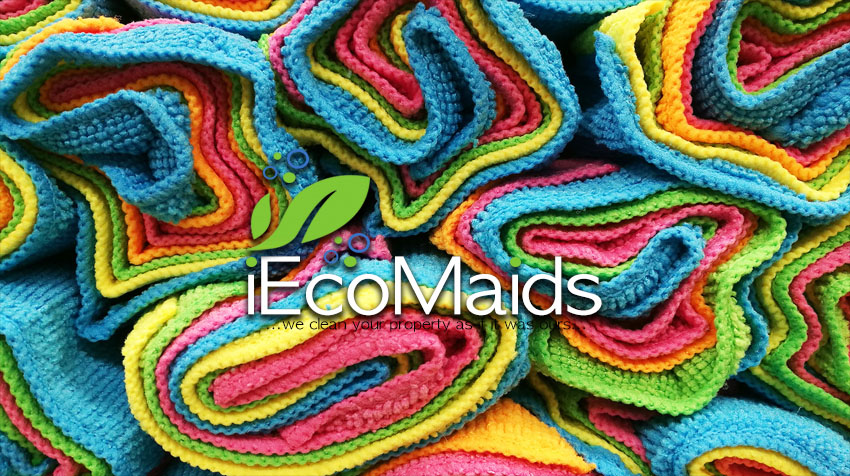Microfiber towels are really good at cleaning, but there are many myths as to why microfiber is the best and how to get the most out of it. Not understanding how and why microfiber works may cause you to overpay for it, shorten its lifespan, and still leave surfaces dirty. So, here’s what you need to know to make the switch to microfiber and vanquish those dust bunnies with confidence.
Myth #1 Microfiber cleans surfaces with magical chemical properties.
False! Microfiber’s magic is purely mechanical. All cleaning towels woven from natural or synthetic fibers work the same way: the fibers absorb liquid, while the spaces and holes in the weave pattern and along fiber surfaces catch and hold dirt. The more spaces and grooves, the more dirt the fabric can hold. Microfiber excels at cleaning due to the thinness of its fibers (ergo the name). One hundred microfibers add up to a single human hair! Makers of advanced microfibers go even farther, shredding the fibers to create even more dirt-trapping power. Fabrics woven from advanced microfibers contain millions of holes and grooves that can trap 100x more dirt than a cotton towel. Microfiber towels make mirrors and wood floors shine their brightest because they’re better than cotton at removing ALL the dirt and soapy water residues that create streaks.
Myth #2 All microfiber towels are the same, so just find the best deal.
Nope. As with all things of worth, ingredient quality and manufacturing methods matter. With microfibers, both the quality and ratio of the synthetic materials comprising the fibers and the machinery used to extrude and weave fibers into fabrics can lead to vast differences in cleaning performance. The best microfiber is usually a mix of polyester—to which oils cling—and polyamide—which absorbs water. Advanced manufacturing machinery, meantime, produces finer, more split threads and can weave microfibers into a wide variety of patterns. Some patterns glide easier when wet, which, for example, reduces fatigue when mopping. Other patterns are designed to be extra scrubby in slippery conditions, making them ideal for cleaning bathrooms. Poorly made microfiber towels absorb less liquid and dirt, shed more broken fibers when laundered, and provide less fiber density per inch, all of which results in you scrubbing harder and longer to clean with towels that last through fewer wash cycles.
Myth #3 Microfiber can be washed with the rest of your laundry.
Once again, false! Quality microfiber costs a few dollars per towel; proper care ensures you get the best cleaning performance and the longest lifespan for your investment. First, using heat to wash and dry microfibers can melt and shrink the split fibers, making your towels permanently less effective. Stick to warm water for washing and dry for the least possible amount of time. Second, microfiber is very effective at picking things up, which means it also grabs loose fibers from other fabrics. Washing microfiber towels in isolation prevents them from picking up cotton and other lint, which can get left behind on mirrors and surfaces. Third, and most important, stick to simple detergents and never use fabric softeners when washing microfiber towels. The oils and polymers in fabric softeners clog the holes in microfiber cloths, making them slick and far less absorbent. If you want your microfiber towels to be soft and fluffy, use plastic dryer balls, which also beat out all the hairs and fibers your towels pick up when cleaning.
Myth #4 Microfiber is so effective you can clean with just water.
Well, sort of. It’s true that microfiber holds dirt, oils, and water, making it an effective substitute for detergents when it comes to lifting light soils away from non-porous surfaces…but that’s where its powers end. Any heavily soiled surface, especially a porous one, needs detergent to break apart thick soils and lift them out of surface grooves and pits. Complex soils, such as soap scum and hard water stains are, in fact, chemically bonded to the surface and must be dissolved by chemical reaction before they can be rinsed and wiped away regardless of microfiber quality. Microfiber also has no ability to kill germs, making it a dangerous replacement for disinfecting cleaners in germ-prone areas such as bathrooms. Any time you need to really clean (versus light dusting), you need water and soap.
Myth #5 You can add silver to Microfiber to make it an antibacterial cleaner.
Kind of. Virtually every cleaning myth (or marketing sham) contains a small kernel of truth. So, yes, you can treat microfibers with costly chemical additives or silver filaments, which do have antibacterial properties. And, antibacterial microfiber towels—which typically sell at hefty markups—do grow less bacteria while waiting to be washed, which means they smell less bad and don’t need damaging bleach to kill off the germs they’ve picked up when cleaning. But they do nothing to protect your family from germs lurking on home surfaces. Soap, water, and quality microfiber will wash away many germs, but if your family is dealing with a flu or tough case of Daycare Crud, you need a disinfectant for high-touch surfaces. As long as you launder microfiber towels promptly with bleach in the wash cycle, untreated (much less expensive) microfiber is all you need.




